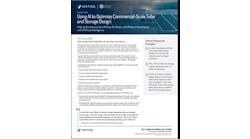Microgrid buyers need to be better educated about why the technology isn’t that complex, why they should consider resilience in addition to cost savings, and why they shouldn’t immediately rule out diesel, say industry members.
According to Ryan Goodman, CEO and co-founder of Scale Microgrid Solutions, a common misunderstanding: “Microgrids are too complicated to develop. It would just be easier to do plain old solar or only a backup generator.”
Truth is, it’s not that complicated to create microgrids, especially if they’re from a provider that owns and operates the system, removing any operation and maintenance headaches, he said.
Bill Becker, renewable energy sales manager at ComAp Group, agreed that clients often think microgrids are too complex.
A simple microgrid might be enough
A microgrid’s complexity is all about what the client is trying to achieve, he said. In many cases, a simple hybrid microgrid can meet the client’s goal of lowering costs. For example, a system comprised of enough PV to offset some fossil fuel, along with diesel or gas, is simple. On the more complex end of the spectrum are microgrids with multiple devices — fuel cells, batteries, PV and controllable loads.
“If it’s a grid connected system where you’re just reducing demand charges from the utility and also providing resilience, it doesn’t have to be that complex. If you’re trying to participate in markets or trying to reduce your carbon footprint, it might be more complex,” said Becker.
Microgrids aren’t one-size-fits-all solutions; they can be customized to meet different users’ needs, he added.
“If customers have a vision of a highly complex system, I’ll ask what they are trying to achieve. If we get down to use cases, we may be able to simplify,” Becker said.
Microgrid resilience saves money
Ryan Goodman, CEO of Scale Microgrid Solutions
Both Becker and Goodman said that customers often fail to consider the value of the resilience provided by microgrids. Instead of a resilient microgrid, they may be looking at a microgrid for cost savings or simply backup generation.
For Becker, clients often fall into two camps: They either want cost savings or they want resilience. He often tells those who are thinking only about costs savings to consider the fact that a microgrid also provides resilience.
“One must calculate the value of resilience when developing solar or backup power projects. When valuing resilience, microgrids are the clear solution,” said Goodman.
To calculate the value of resilience, Goodman suggested that potential microgrid buyers consider the costs associated with the recent power outage in Texas. The electricity generation failure spawned water, food and heat shortages. The price tag, according to Goodman: $195.6 billion and 111 deaths. Potential microgrid buyers can also consider Lawrence Berkeley National Laboratory’s interruption cost estimate. For medium and large commercial and industrial customers, an outage can cost more than $10,000 per event. For all classes of customers, the cost is about $875 per event, in 2016 dollars.
It’s also important to remind clients that the nation’s grid is aging and may not always be reliable, said Goodman. Some components are more than a century old and are far past their life expectancy. Seventy percent of transmission and distribution lines are well into the second half of their life span.
Diesel sometimes makes sense
In addition to microgrid complexity and the value of resilience, customers should be better educated about diesel use in a microgrid, said Becker.
Customers often tell Becker that they believe diesel is bad. Some begin by saying they only want a 100% renewable microgrid.
Bill Becker, renewable energy sales manager at ComAp Group
He argues, however, that putting together a microgrid with more than 80% renewables can quickly get expensive. Diesel, which is often used only a few days a year, along with renewables, can make the economics of a microgrid more attractive — and still allow for a high level of renewable energy.
When projects focus on 100% renewables, the cost increases dramatically above about 80% renewables content, he said. That’s because designers must size the renewable energy and battery to cover the worst case scenario: multiple days without enough solar or wind.
“You basically have to size your system very large to cover the unusual case that maybe happens a few times a year,” said Becker. “It becomes so expensive to get that last 10% of renewables out of a system. A diesel generator hardly ever runs. It gives you backup and you hardly need to use it, and can make the whole project move forward.”
Rational microgrid buyers
Ultimately, when microgrid buyers are well educated, they generally make a rational decision. “But the conversation doesn’t always start that way,” said Becker.
Join us at Microgrid 2021, an event designed to help potential microgrid buyers better understand the technology and how it might serve them. The virtual event begins May 11 with a look at microgrids and resilience through webinars, panel discussions, a virtual tour, networking and exhibits. Registration is free if done in advance. Only those who have registered prior to May 11 can attend the May 11 sessions. Microgrid 2021 runs through June 3. See the agenda here.









